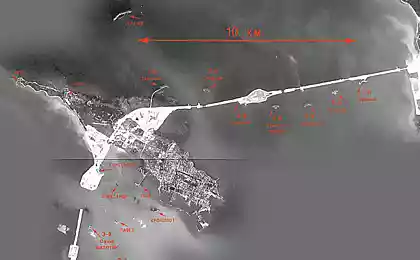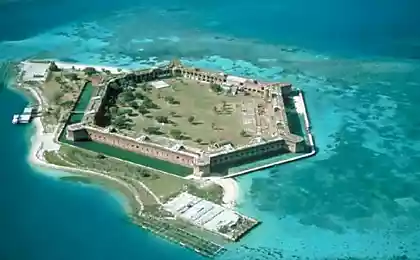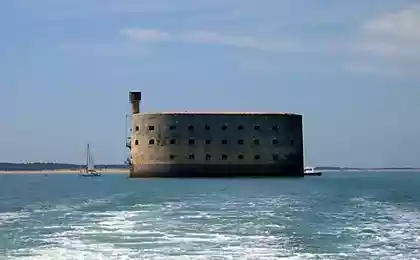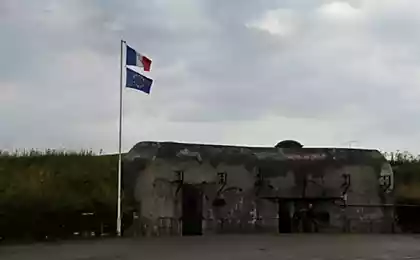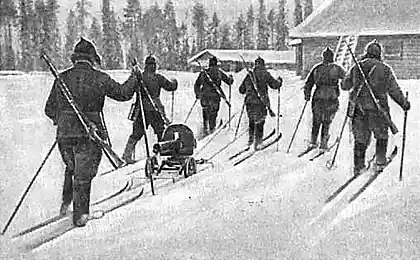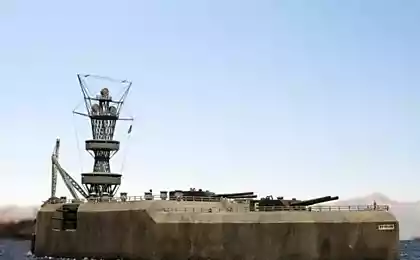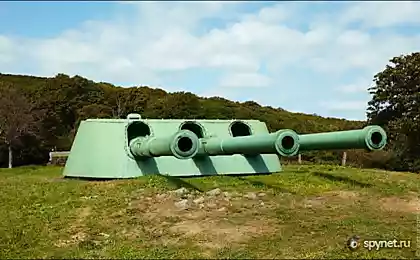1598
30th bronebashennaya batareya.Fort "Maxim Gorky-1"
Actually search found only topic of 2011 on the same 35 battery blogger aquatek-filips'a also read. I wonder ...
Next repost itself. Photos are many traditional request doterpet through.
250-day defense of Sevastopol 1941-1942. It has become one of the most brilliant pages in the history of World War II. Defenders of the main base of the Black Sea Fleet thwarted the plans of the German command on the offensive in the Caucasus, it will affect the whole course of the war. A significant role in the defense of Sevastopol played the 30th and 35th tower shore batteries, which formed the basis of artillery power of the defenders of the city, causing significant losses to the Germans, and bound themselves to enormous forces of the enemy.
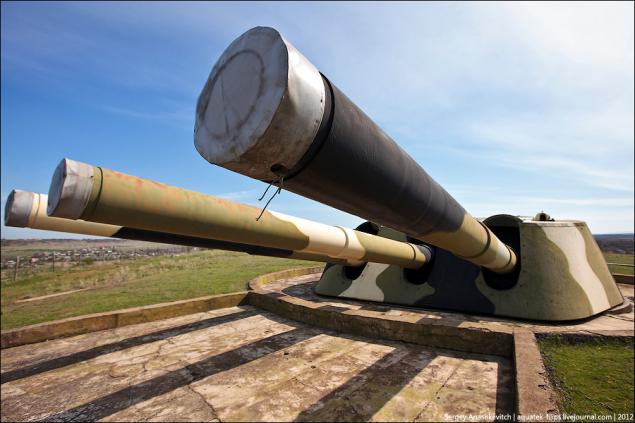
30th Battery fought until 27 June 1942, until it is completely blocked, are not captured by the Germans. After the war, the battery has been restored (unlike the 35th Battery, which remained abandoned for many years, and only in recent years, the efforts of its patrons managed to turn into a museum), adopted its efforts, installed new fire control system and life support. To re-batteries used two three-gun turret installations battleship "Poltava" (the other two towers of the battleship in the 1930s have been installed on the battery to them. Voroshilov on the Russian island near Vladivostok). 30th battery is still among active military units of the Russian Federation.
On the eve of Victory Day, thanks to the invitation of the press service of the Black Sea Fleet of the Russian Federation, I was able to go on the battery, which 70 years ago was not so quiet and peaceful, and exploded a huge 600-mm shells and killed people ...
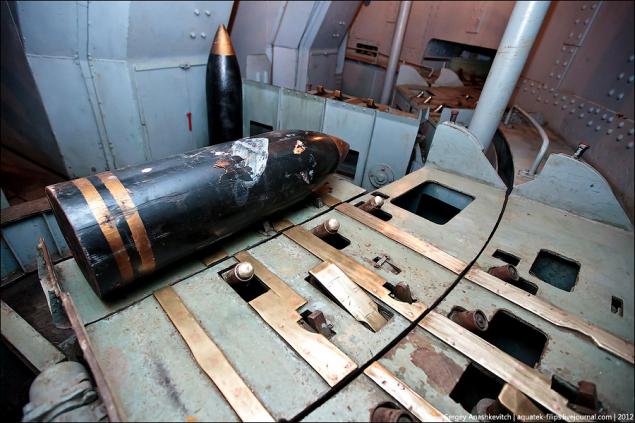
One of the results of the analysis of defense of the fortress of Port Arthur during the Russian-Japanese war of 1905 was the decision to build on the commanding heights on the wings of Sevastopol defensive area the two most powerful on the Black Sea shore batteries: №30 - near the village of Lyubimovka, at the mouth of the river Belbek, number 35 - at Cape Chersonese. Each battery had 4 caliber 305 mm guns mounted in two rotating cupola (the battery №30 - one artillery unit into two cupola, and the battery №35 - two artillery unit on the cupola one each).
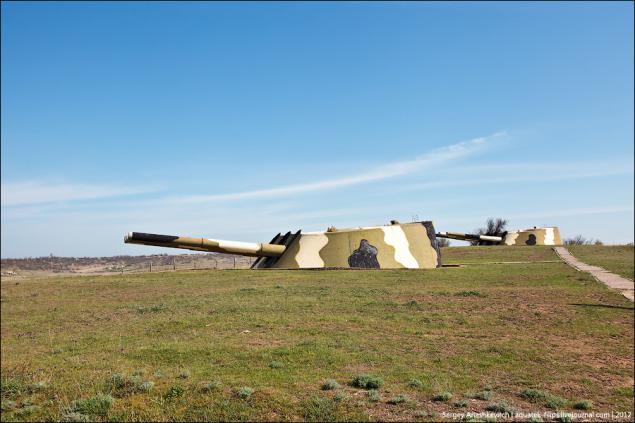
Bronebashennuyu battery into the mouth of the river Belbek began to build in 1912, with the advice Cui, who studied the special features of the defense of the city in 1854 - 1855 years, suggested to her the most advantageous position. It was a hill, some curved and one side facing the sea. By 1914, they managed to dig pits for towers and several underground cellars, followed by the construction of the battery mothballed since Russian Navy dominated the Black Sea in 1914 - 1917 years, and the ships of the enemy did not dare to appear near its base.
In the late 20s the Navy Command of the Black and Azov Seas has decided to complete the construction and asked the Defense Commissar Voroshilov support. People's Commissar of the project approved, and work started immediately. Experts save every ruble - used in the construction of many of the mechanisms and parts left over from the heavy warships king's fleet.
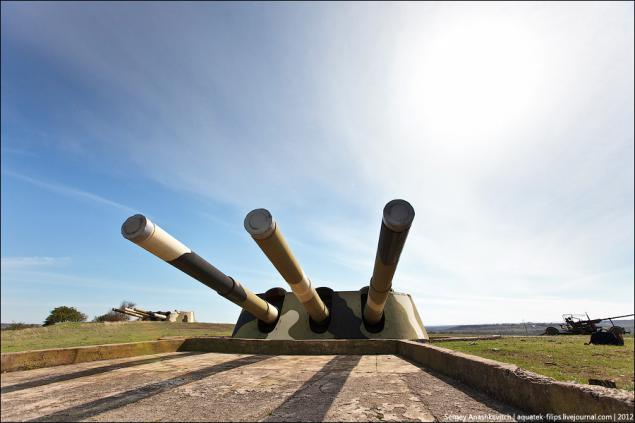
In 1933, coastal defense battery, power salvo equal battleship, was commissioned. She was given number 30, was appointed commander of the graduate of the Moscow Artillery School, Captain George Alexander, the military commissar - Politruk Ermila Solovyov.
The domination of the surrounding area provided a cupola, rotates through 360 degrees, the circular firing. Maximum range of up to 30 km.
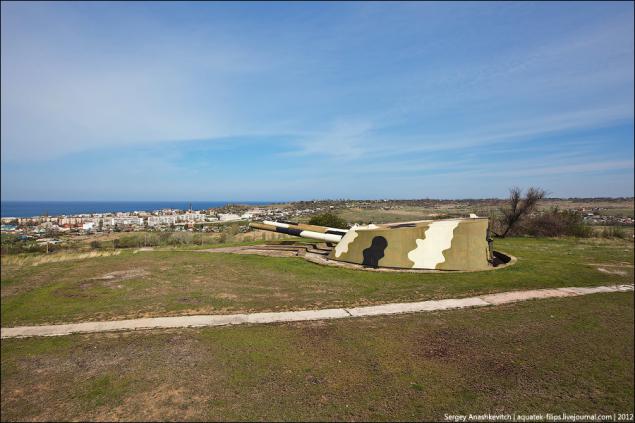
Both batteries - and the 30th and 35th - originally built as a shore, that is, were designed to combat enemy ships. But when in October 1941, German troops invaded the Crimea, the coastal batteries designed to protect Sevastopol from the sea, have become a major caliber defense of the city from the land.
The German documents Sevastopol coastal batteries were called "Forte", "Maxim Gorky-I» (battery №30) and "Maxim Gorky-II» (battery №35). 35 battery is located within the area of the German offensive, so the brightest part in the defense of the city was destined to play "thirty" under the command of Major Alexander. German generals and fortification stated that "Fort Maxim Gorky-I», is "a true masterpiece of engineering", "by virtue of its exceptional qualities could delay the fall of Sebastopol for more than six months." Batteries subjected to continuous bombardment from the air and shelling from heavy and heavy guns.
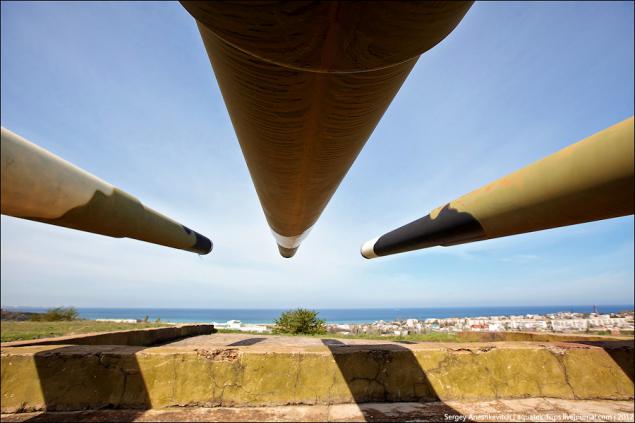
According to the memoirs of the commander of the German army in the Crimea, Manstein, "the whole of the Second World War, the Germans never reached such massive use of artillery in the attack on Sevastopol." According to his testimony, the city fired artsily in which "among high power batteries were cannon battery systems with up to 190 mm caliber, and several howitzers and mortars batteries caliber 305, 350 and 420 mm. In addition, there were two special guns caliber 600 mm (type mortar "Karl") and the famous gun "Dora" caliber 800 mm "(quoted).
When the battery defenders reported to the Command Headquarters of the Germans hit the battery 610-mm projectiles, which results from the cracking concrete, they did not at first believe. I had to give evidence about making the photograph of unexploded ordnance mortar "Karl" caught in the battery.

Today, the museum of the 30th Battery exposed one of those very fragments of shells, which the Germans tried to destroy the battery.
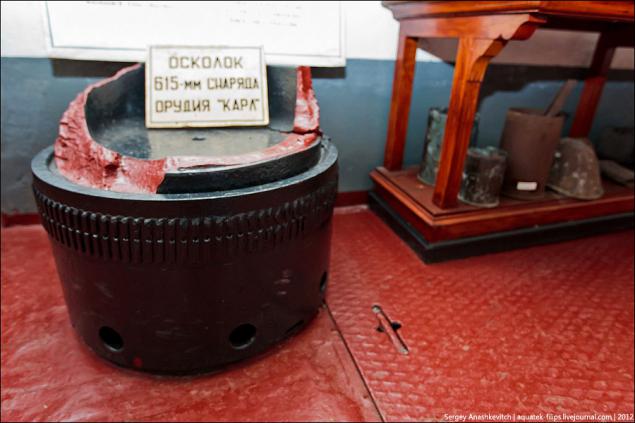
Battery fought to the last bullet. June 17, 1942, she was completely blocked by the adversary, June 18, the last shot shells, June 21 personnel was blown equipment citadel. The battery remains surrounded by about 200 people - the gunners, soldiers of the 95th Infantry Division and Marines. 9 days they were fighting in the dungeons and underground facilities ...
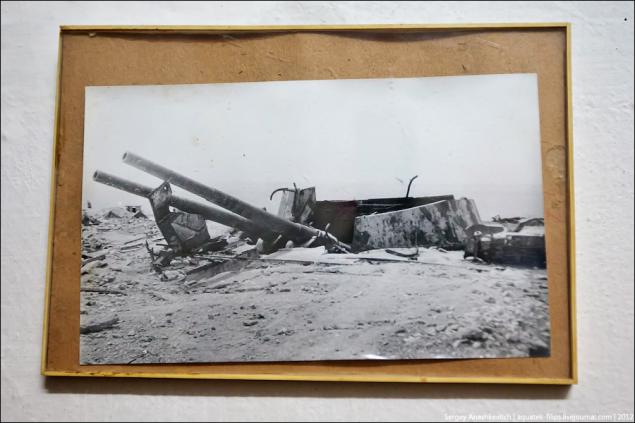
German and Romanian generals seized inspect battery. Incidentally, it is interesting to compare the complexion of the enemy generals Soviet commanders on the next photo ...
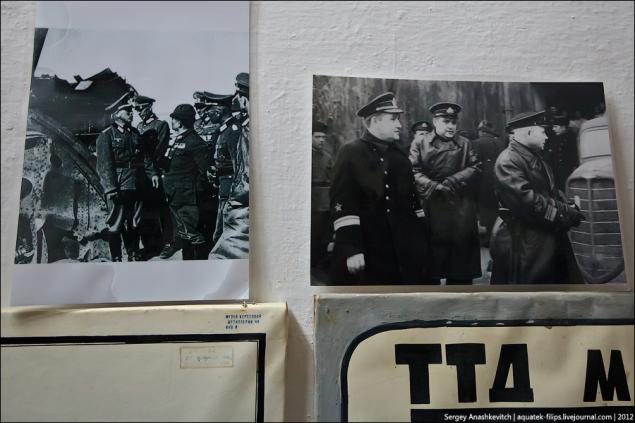
After the war, the battery has been restored, adopted its efforts, installed new fire control system and life support. Today, it is among the current Russian military units.
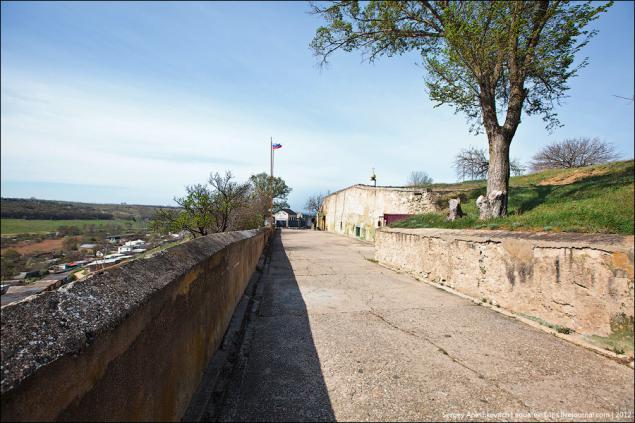
Entrance to the casemates battery - turret room. At the entrance to a memorial sign its defenders.
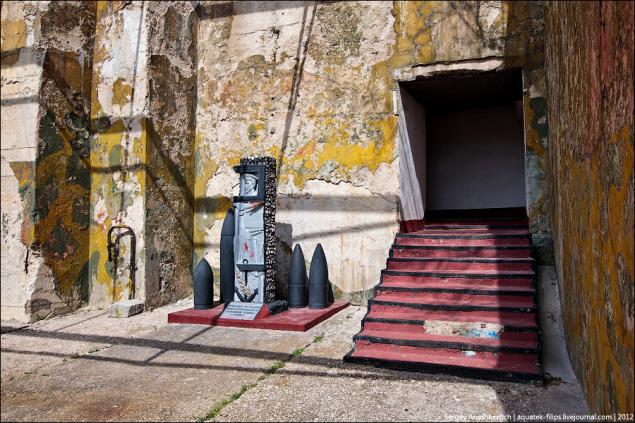
Alarms and plaques, do not forget to give today's soldiers immortal names of people who gave their lives in that war
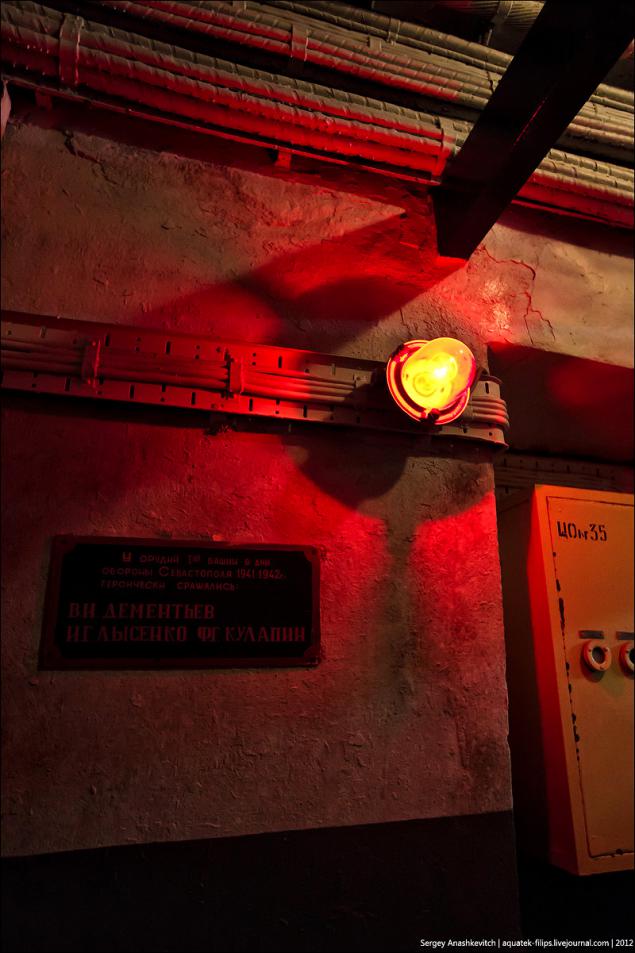
Long corridors, inspection gallery are under both gun turrets. Casemates placed a full calculation of the battery.
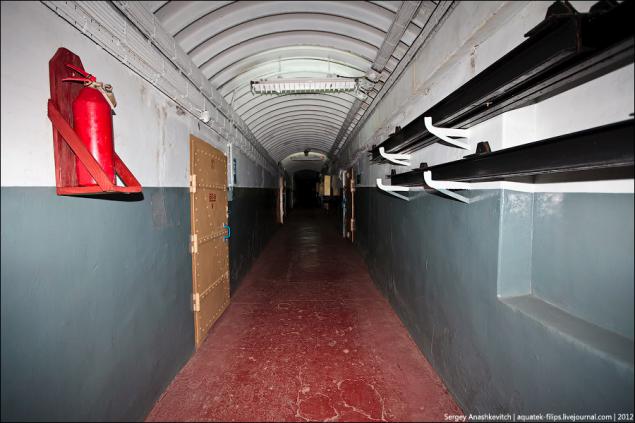
Each room is protected by armored door, allowing you to save personnel and equipment from explosions. Poterna device and placing them in the space allowed defenders to conduct corridor battles using the door as a shelter
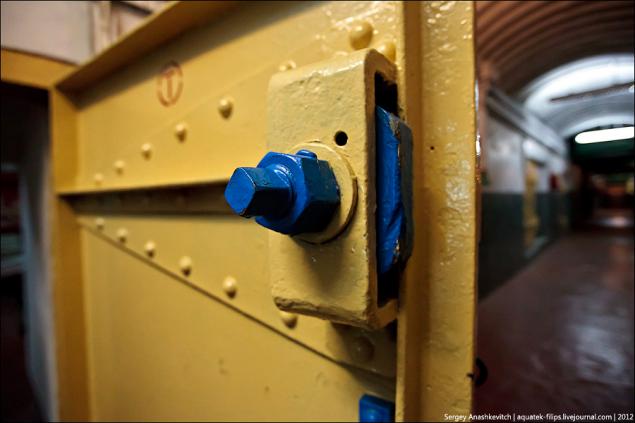
Fasting energy and vitality. Heart and battery power.
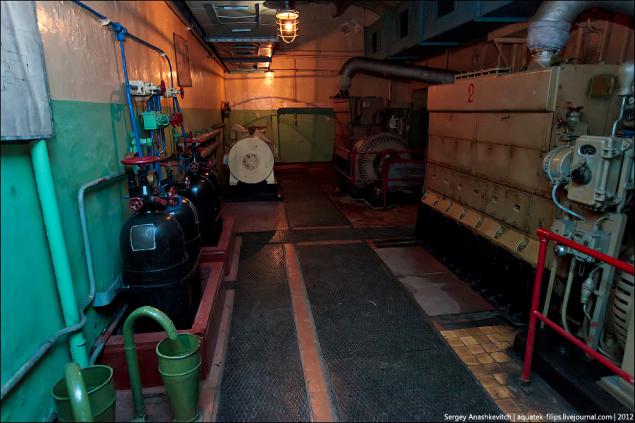
Control systems
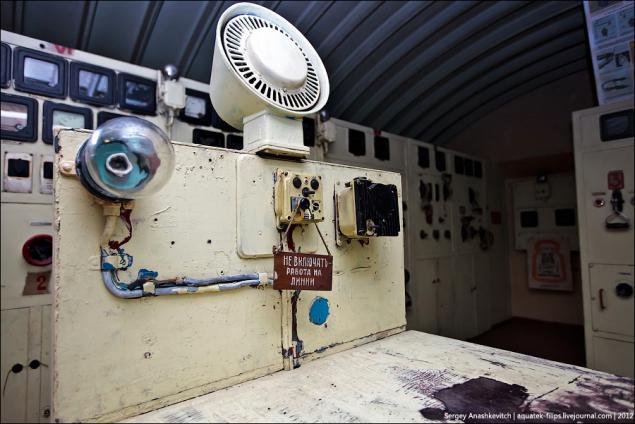
The command bridge
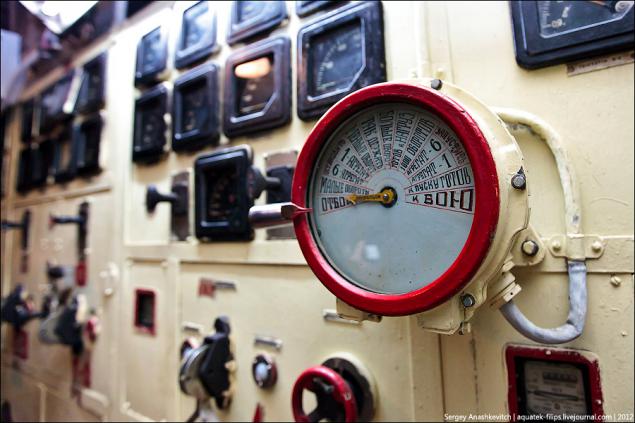
Reserve helm fire
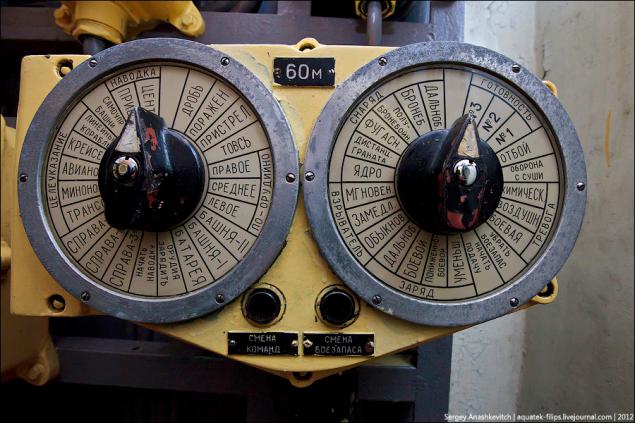
...
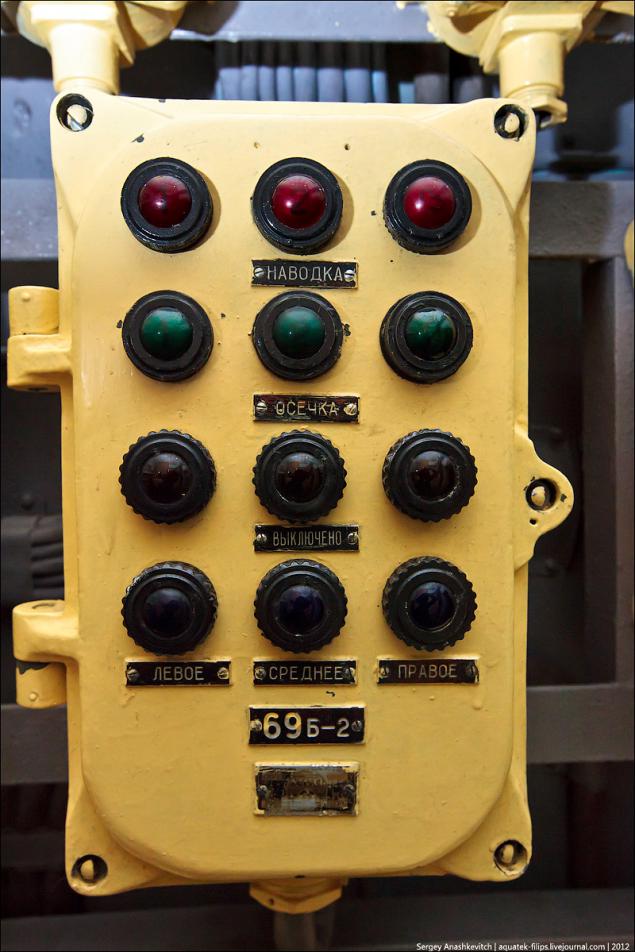
The strategic map of the waters of the Defense of Sevastopol from the sea
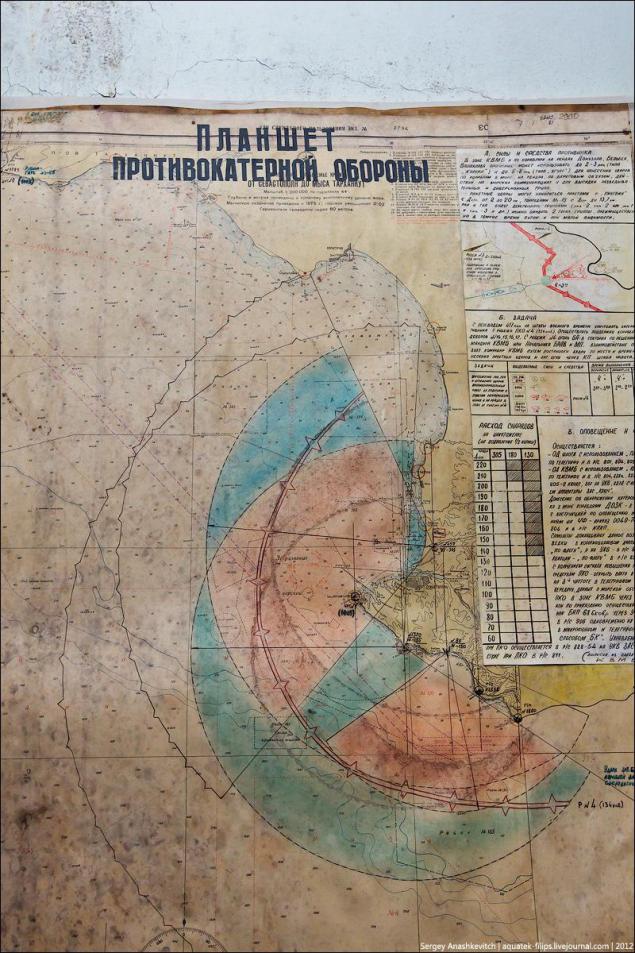
During the war, Sevastopol was much smaller than today's ...
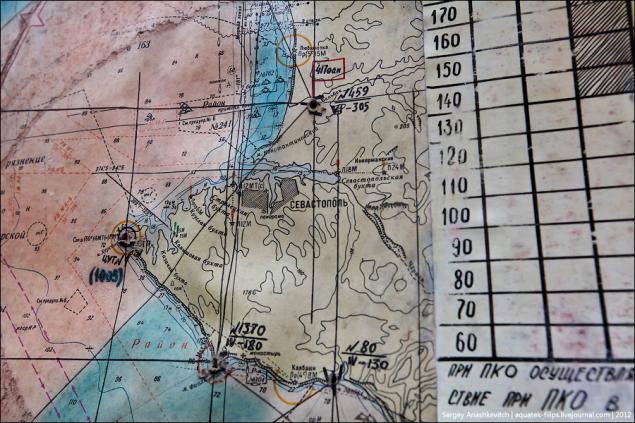
...
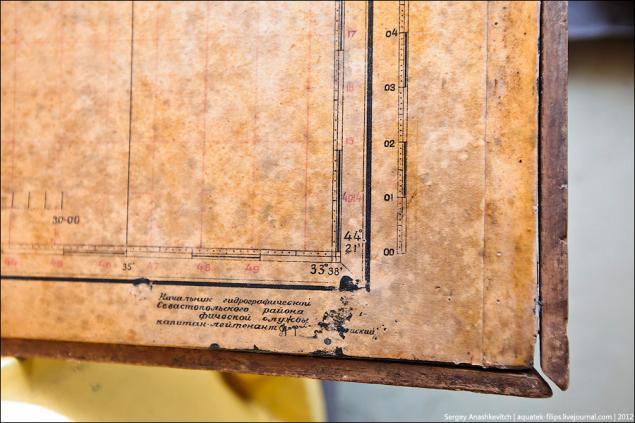
...
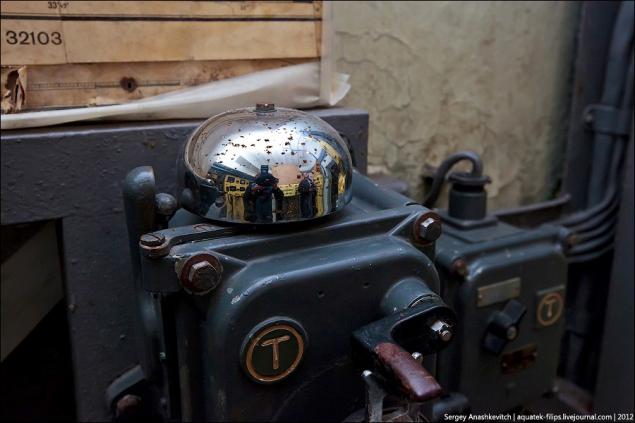
Login podorudiynoe room. They kept the shells and set feeders for them
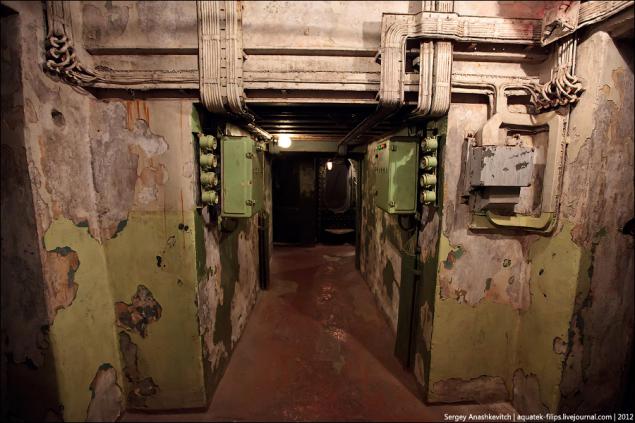
Feeders shells. Projectiles and powder charges are stored separately. On these shelves during the defense of Sevastopol were high explosive, fragmentation, high-explosive, armor-piercing, concrete-piercing, high-explosive armor-piercing, shrapnel, incendiary, smoke, illumination shells and bombs ... with leaflets
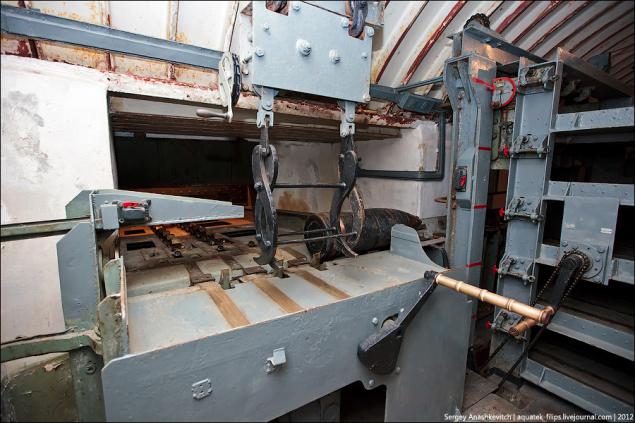
Mechanisms are equipped with electric and manual drives, allowing the shell to file even if energy supply disruptions from the battery. Special probes capture the huge disc from the rack and shift on the transfer belt
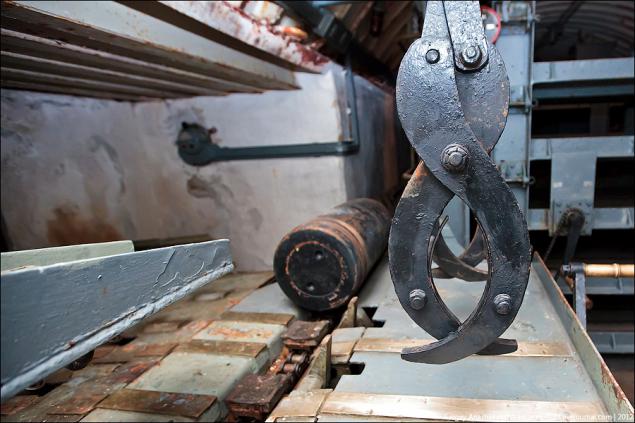
For this tape shell is served in the turret room
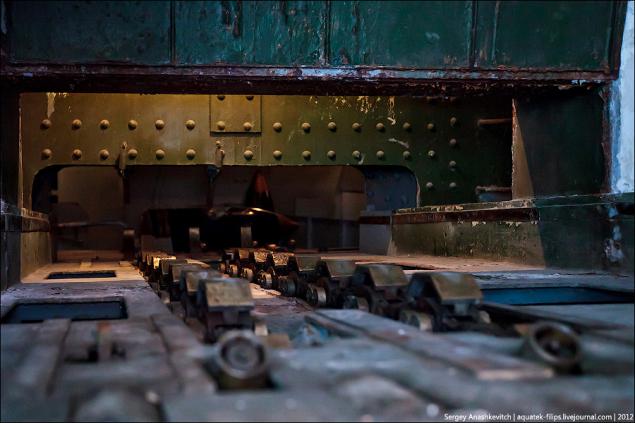
In the interior of the tower.
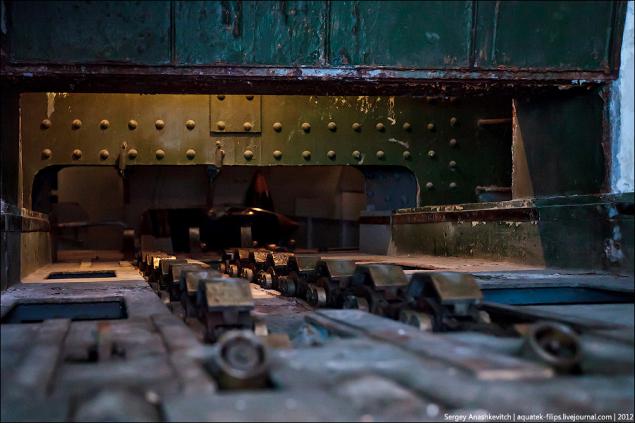
Communications

Flickering light bulbs and drone metal ...
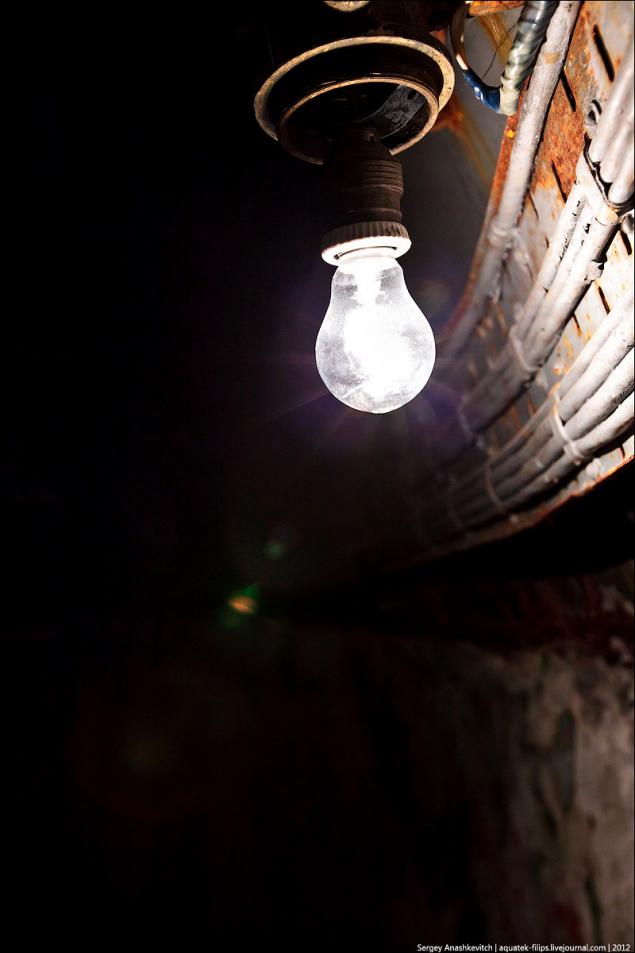
Entrance to the tower itself. Rather, in the lower part of
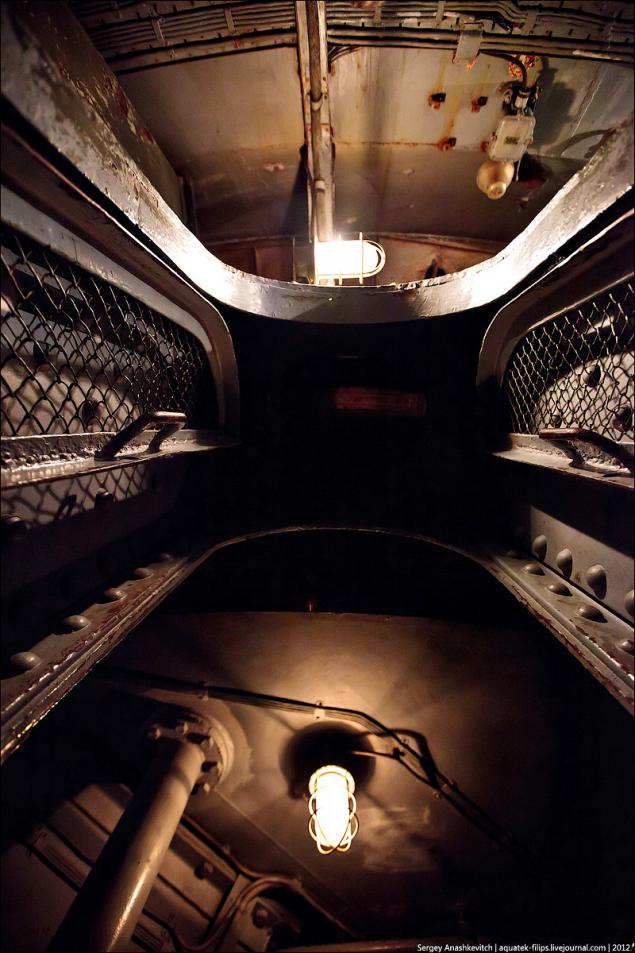
...
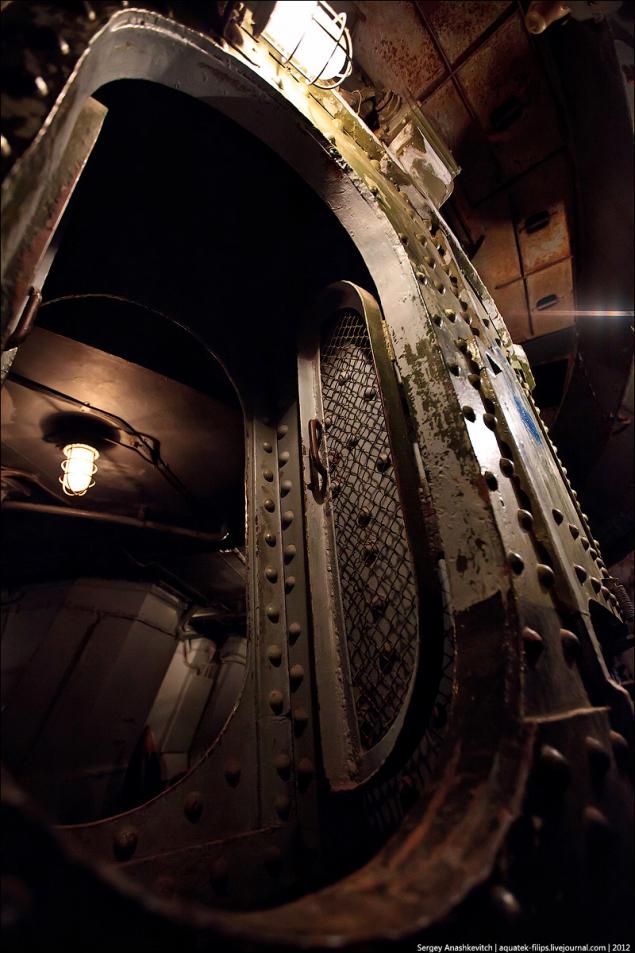
Electrical cables and intercom
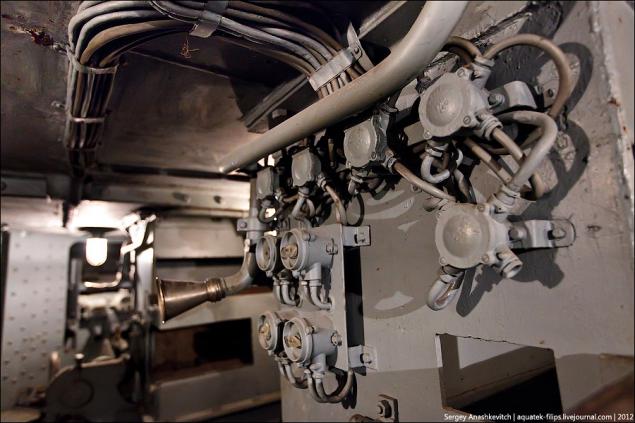
Tray feed powder charge

The handle lock-feeder
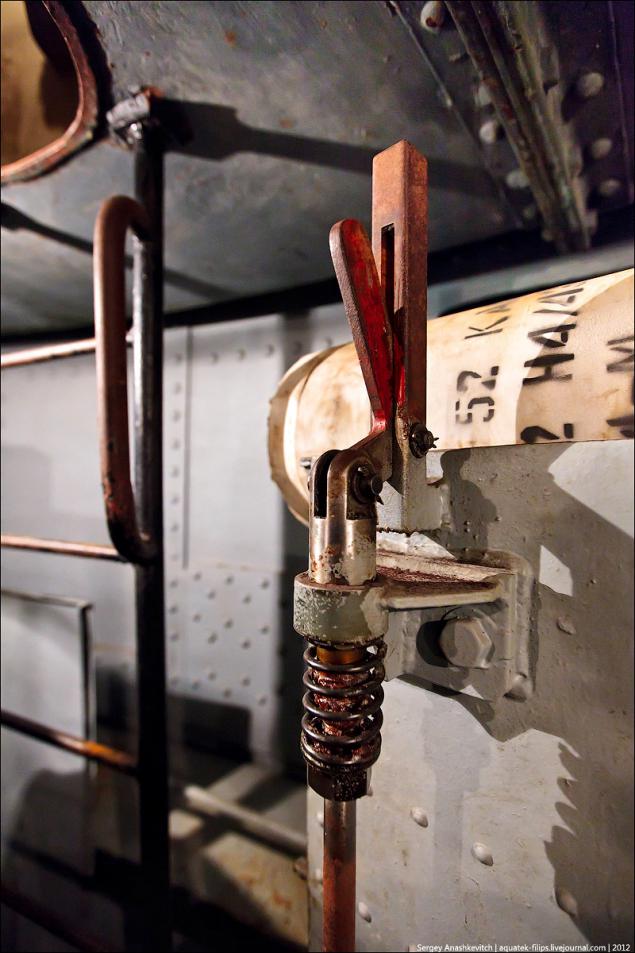
Intercom
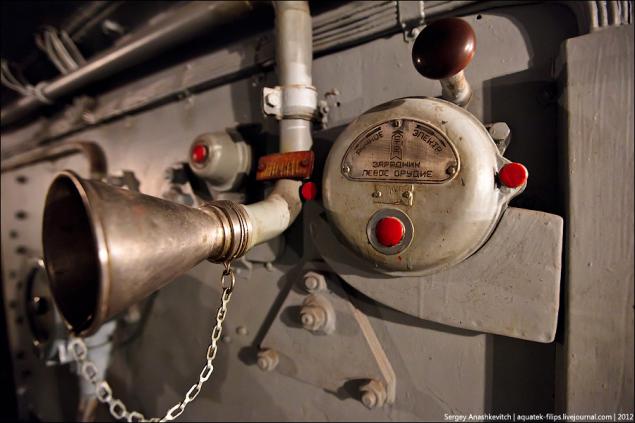
Chargers trough
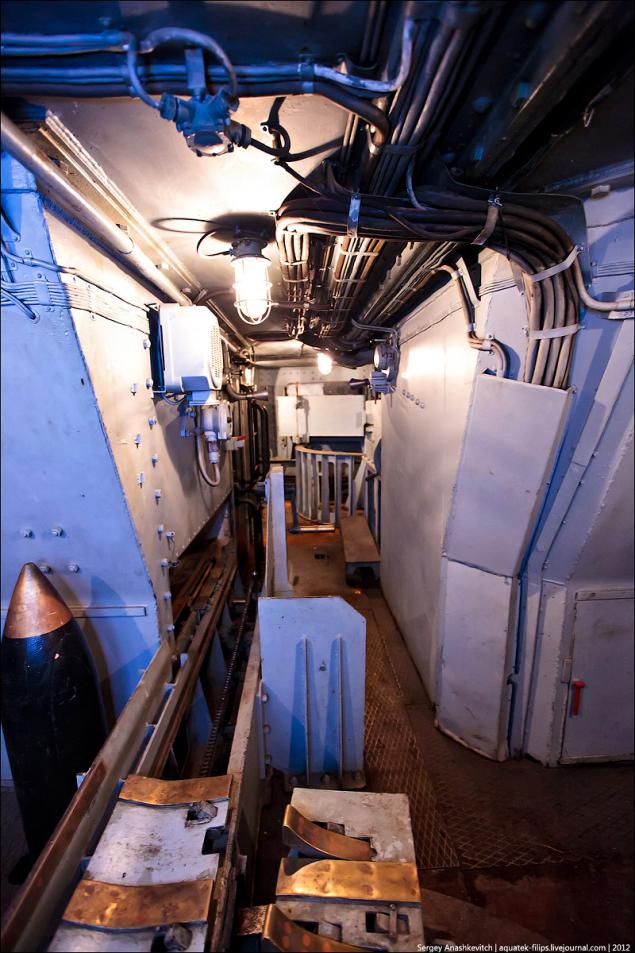
Turntable pass shell with tape on the supply chute.
How is the process of filing shells
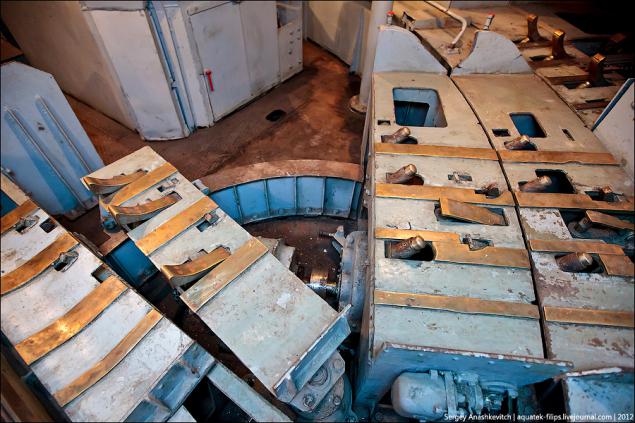
Kubrick personnel.
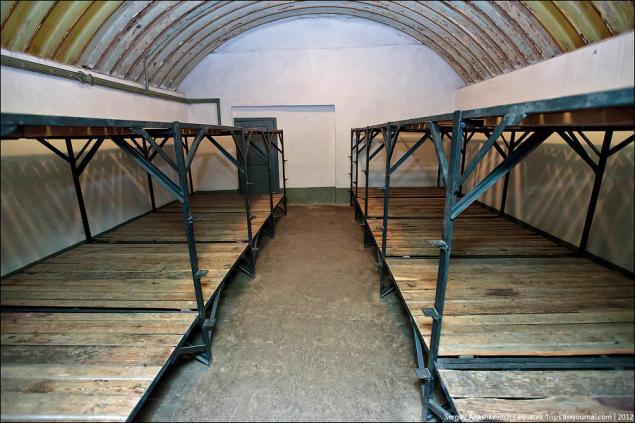
Telephone device for the rapid communication
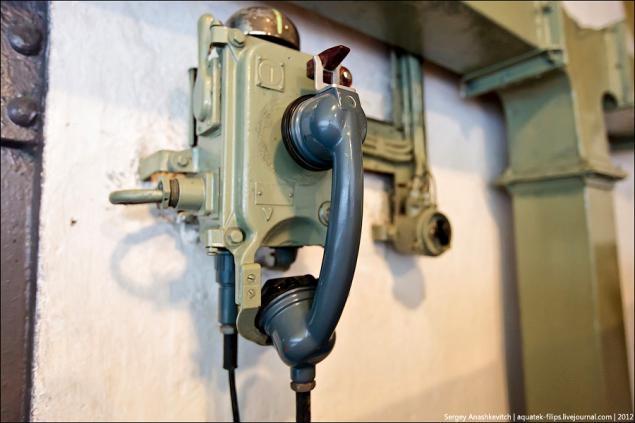
A water tank. In the case of the siege, the personnel could be quite some time on a standalone security
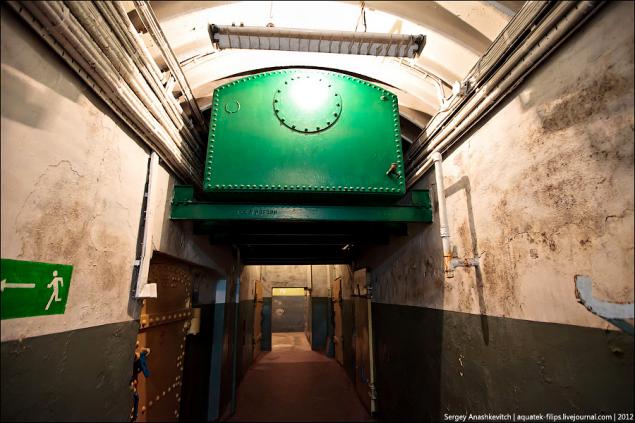
Security door in the living cabin
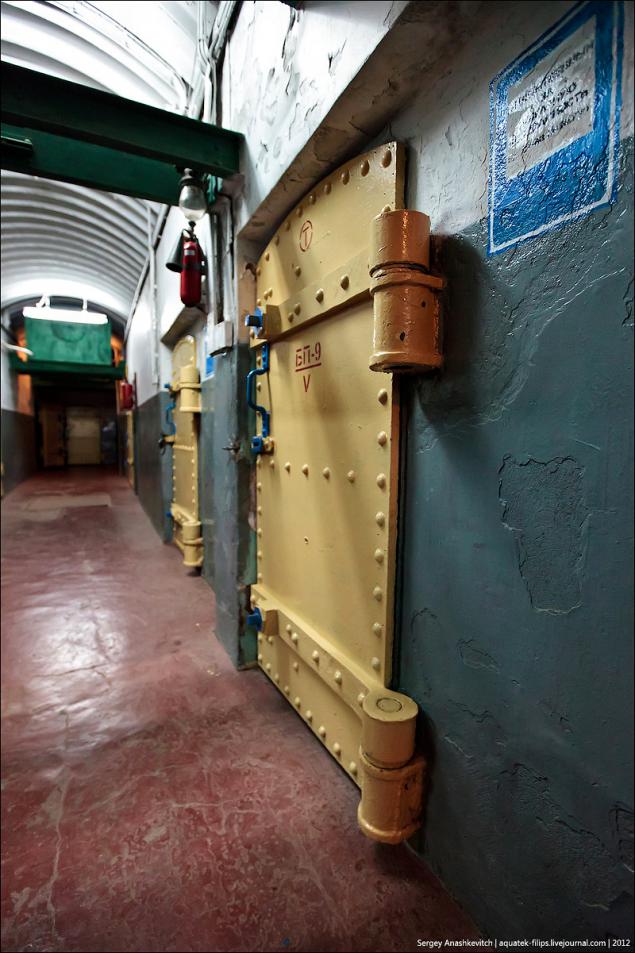
Everywhere on the walls are fixed rails, which are used to supply ammunition and powder charges outside the place of storage.
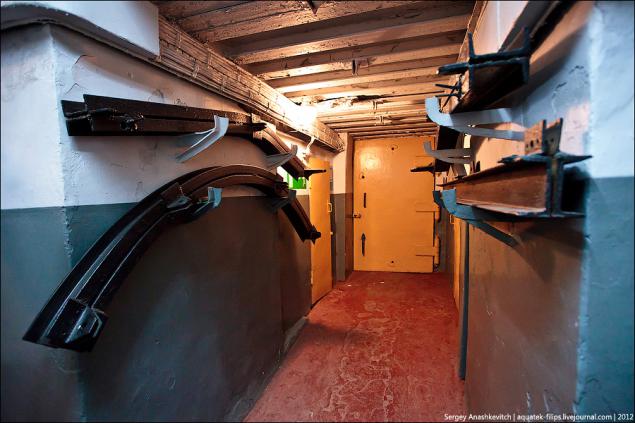
That's how they look when assembled
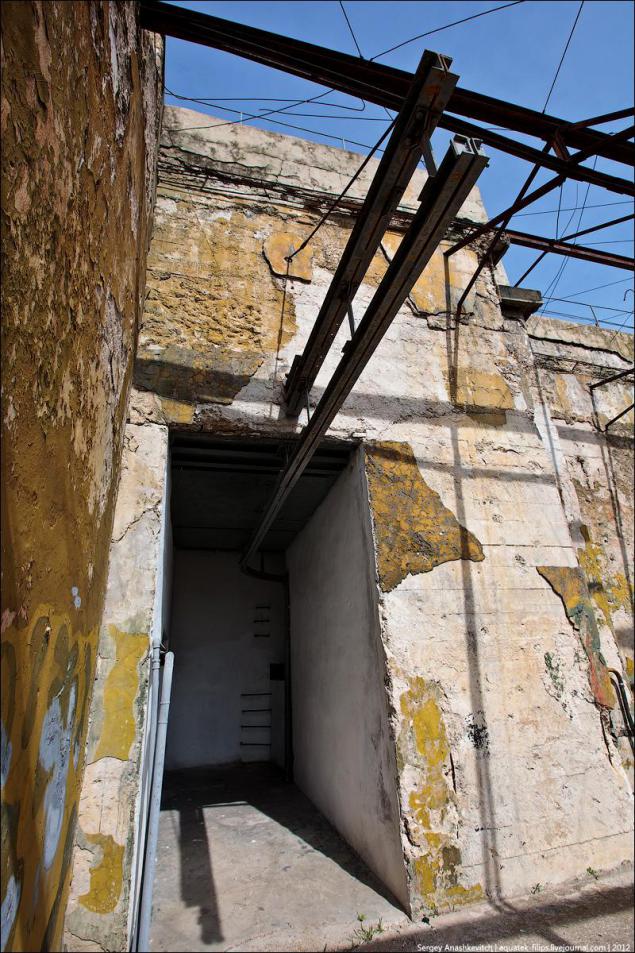
Breech guns from the battleship "Poltava", installed on the battery today
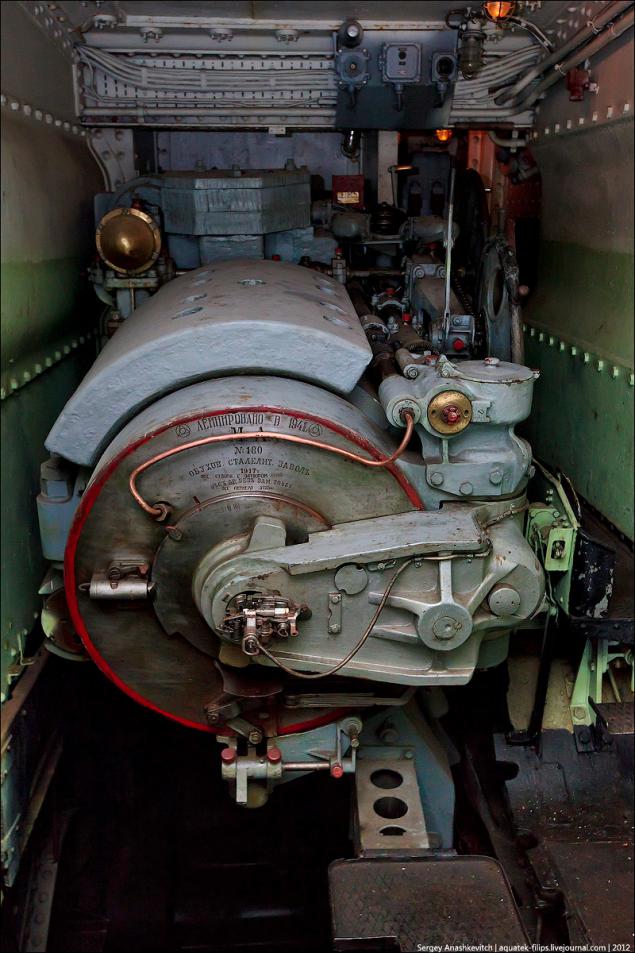
Control toggle
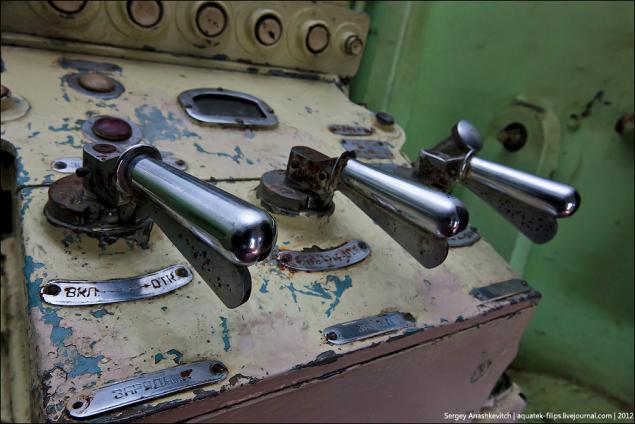
Breech
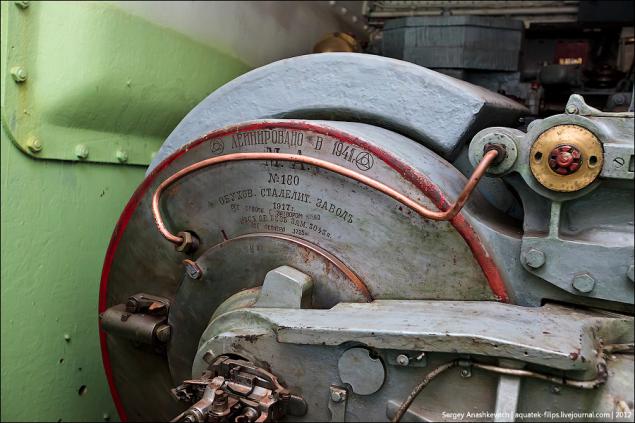
The base of the trunk
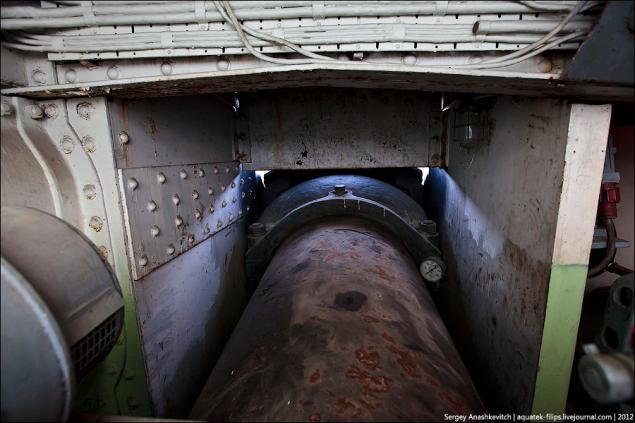
During the battle here is not to hear the commands. So they served visually
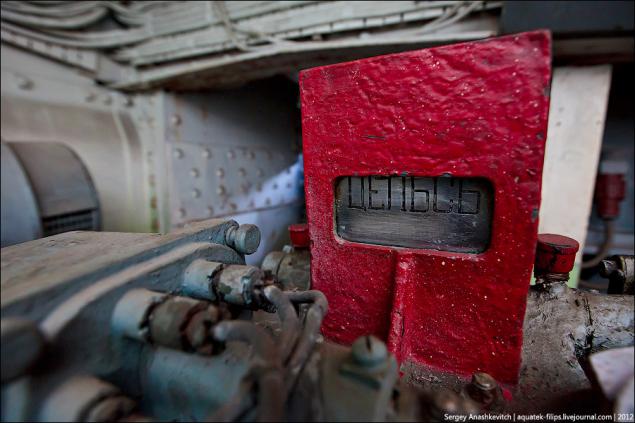
The barrel weighs 50 tons. It is worth noting that at the beginning of 1942, began to fall and the accuracy of the firing range. Affected wear trunks - rifling in their channels were erased, so after the departure of unstable ammunition kept on track. In a strictly secret location in one of the bays have a spare 50-ton guns. By replacing manual work with trunks required special cranes for 60 days. During the long winter nights, the gunners by "Burlatskii cooperative", almost by hand, using a small crane and jacks, just 16 days to replace the barrels "thirtieth". The distance to the enemy in those days was only 1, 5-2 km ...
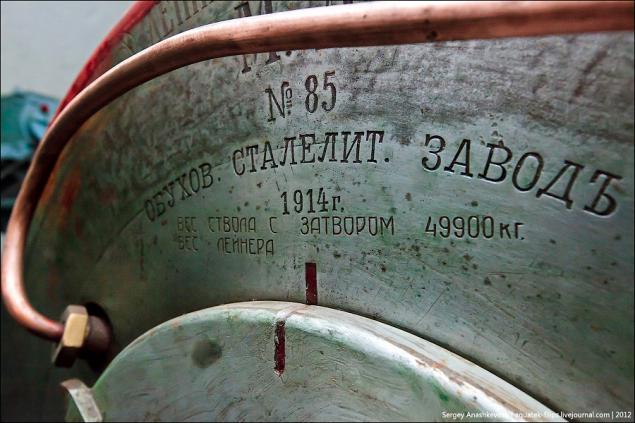
All mechanisms in grease and in working condition
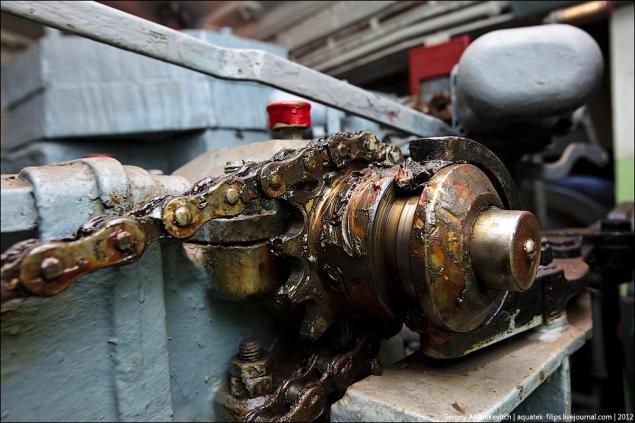
All three trunk in each tower can shoot independently from each other and are separated by separate cameras chargers
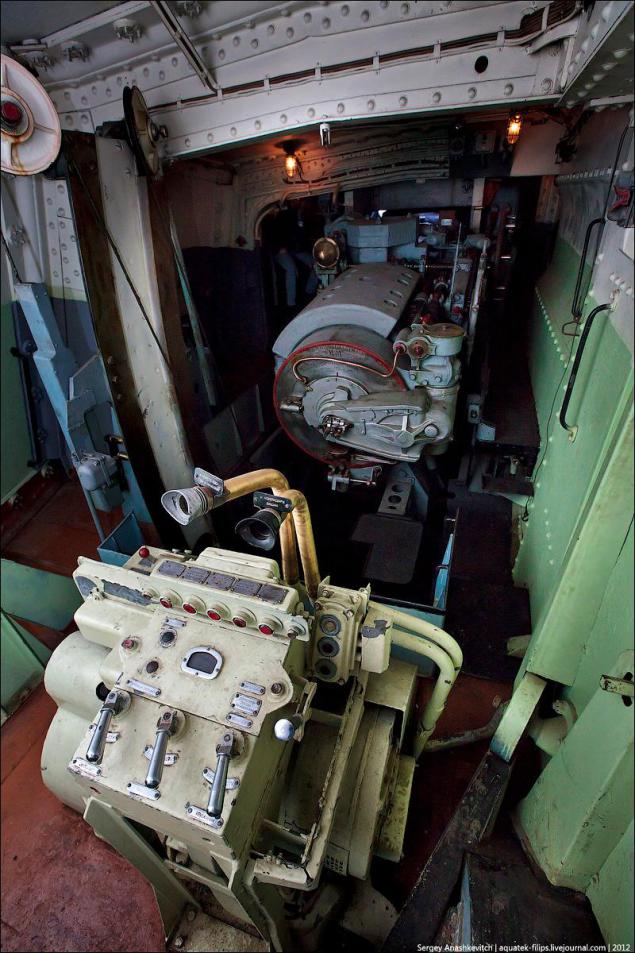
"Eye" Gunner, located on the upper part of the tower
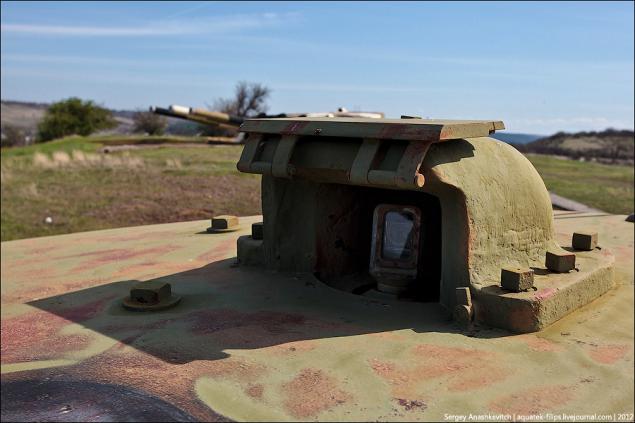
Stairs from the tower to the ground
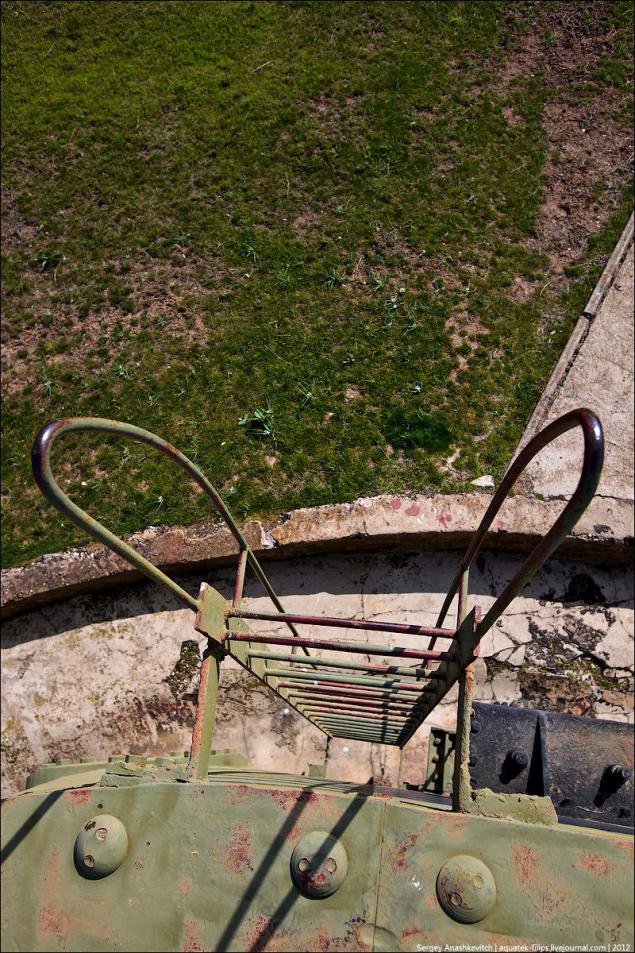
In one room there is a small museum where collected, found in the territory of the 30th Battery, traces of those fights
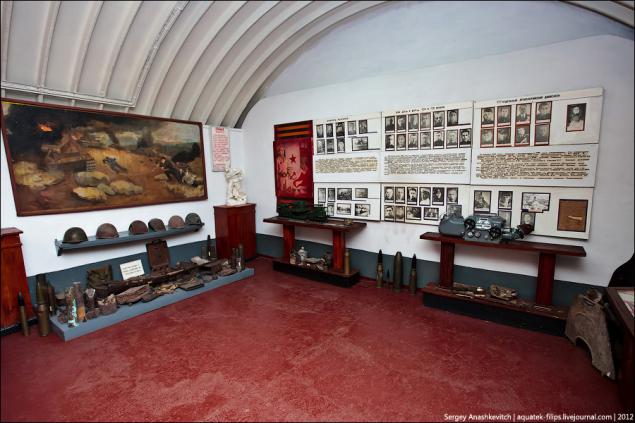
According to the military, everything was just littered with shrapnel and pieces of shells, mines and roadside bombs.
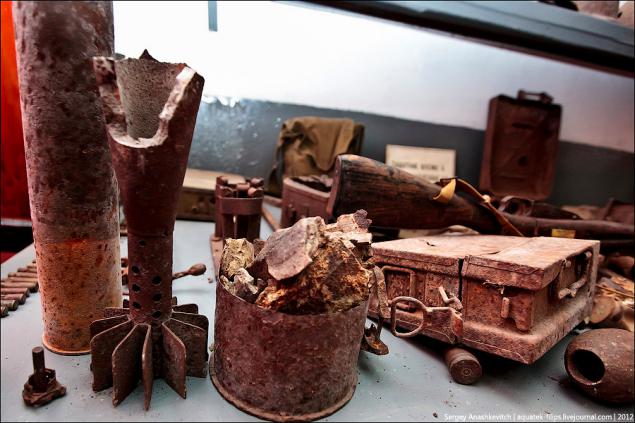
German plates issued in 1941 ...
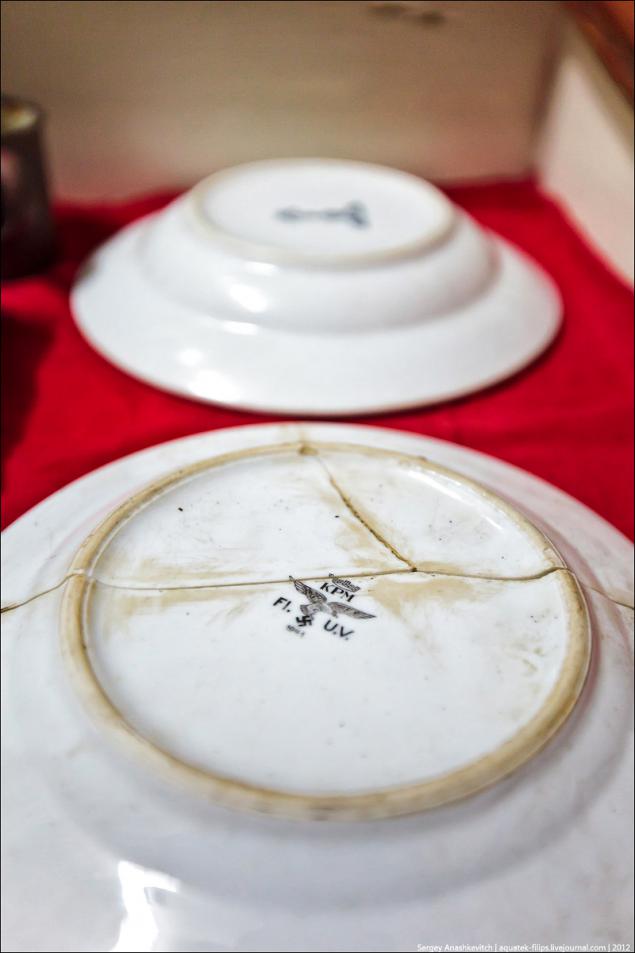
Germans carefully studied Soviet weapons. Memo platoon commander with a German stamp on the cover
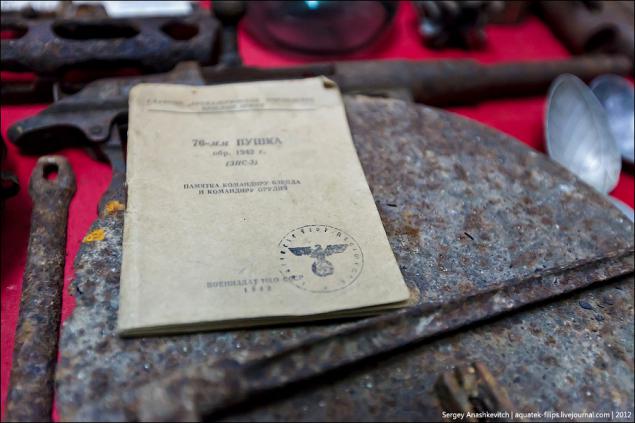
...
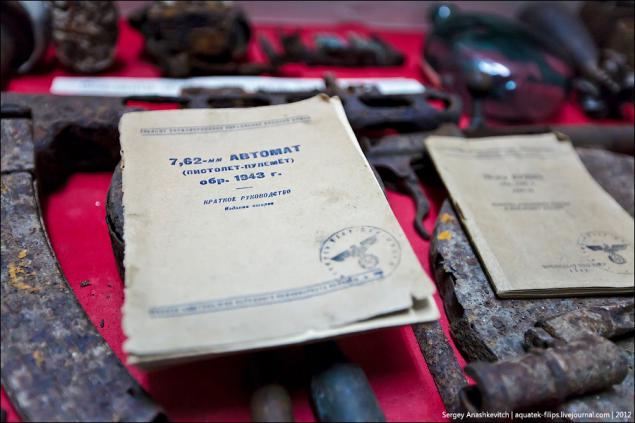
German military book
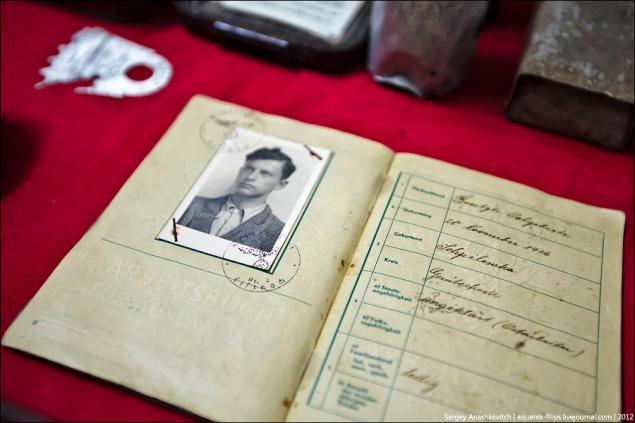
Decaying submachine gun and a grenade
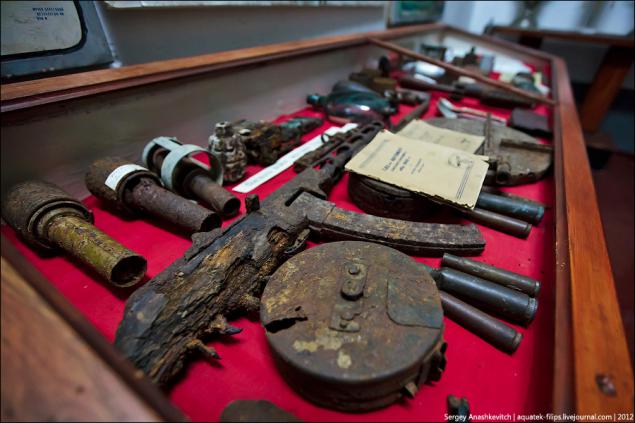
...
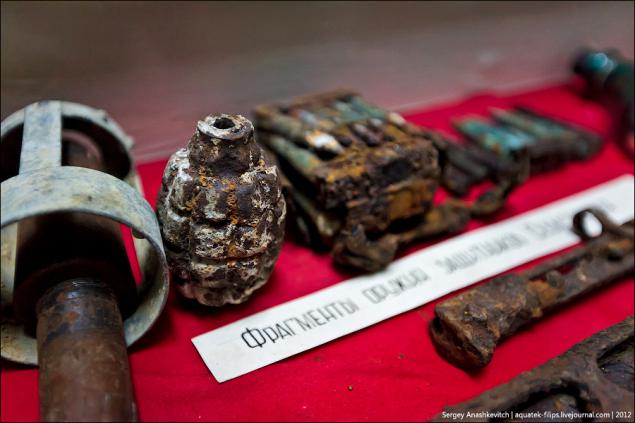
...
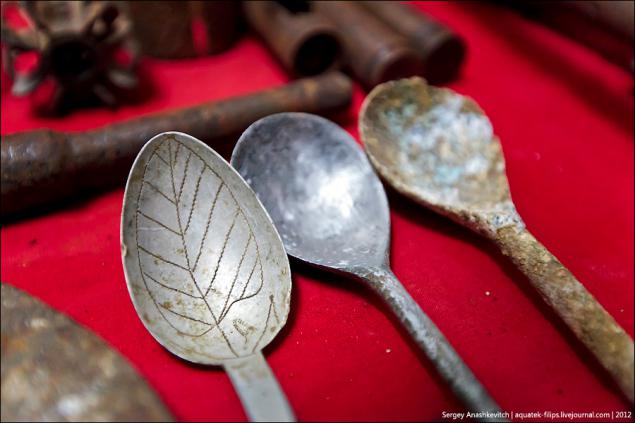
...
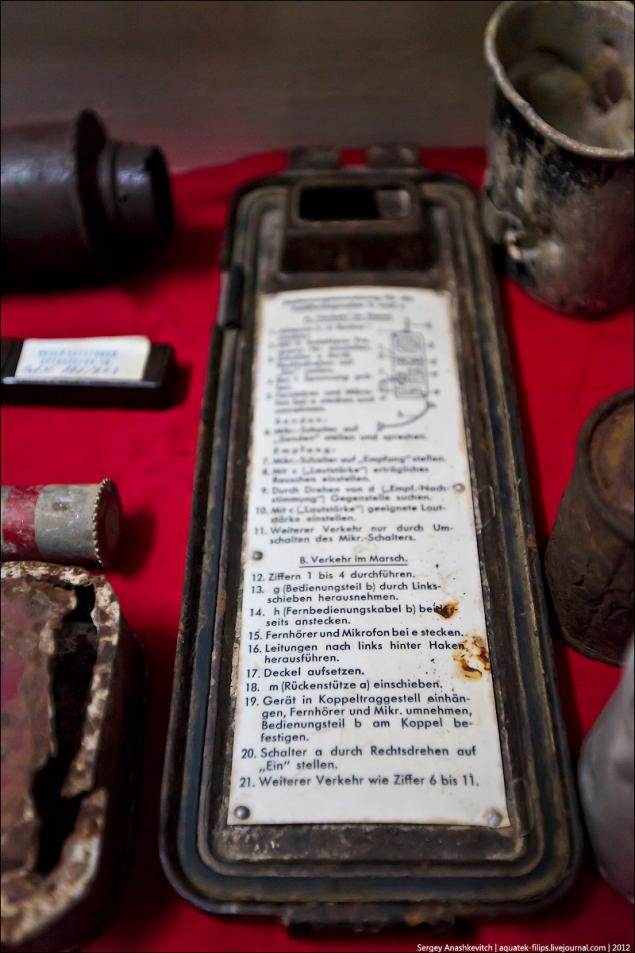
Spring 2012. 70 years have passed since those days. Going out into the fresh air of the casemates, impregnated by the war, there is a feeling within some nagging pain ...
Posted in [mergetime] 1336556146 [/ mergetime]
The report was prepared with the assistance of command of the Black Sea Fleet of the Russian Federation. Sergei via Anashkevich. Thank you for attention. All.
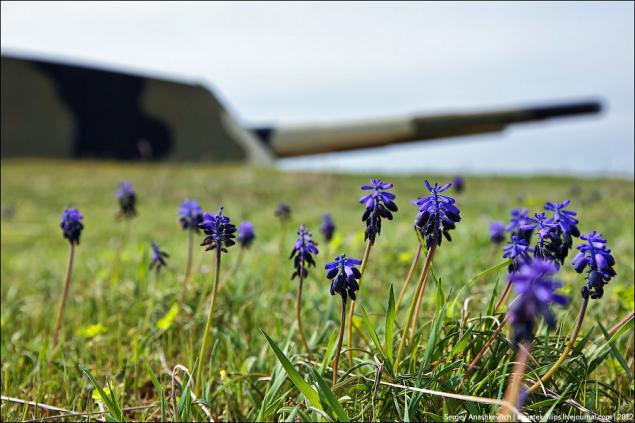
Source:
Next repost itself. Photos are many traditional request doterpet through.
250-day defense of Sevastopol 1941-1942. It has become one of the most brilliant pages in the history of World War II. Defenders of the main base of the Black Sea Fleet thwarted the plans of the German command on the offensive in the Caucasus, it will affect the whole course of the war. A significant role in the defense of Sevastopol played the 30th and 35th tower shore batteries, which formed the basis of artillery power of the defenders of the city, causing significant losses to the Germans, and bound themselves to enormous forces of the enemy.

30th Battery fought until 27 June 1942, until it is completely blocked, are not captured by the Germans. After the war, the battery has been restored (unlike the 35th Battery, which remained abandoned for many years, and only in recent years, the efforts of its patrons managed to turn into a museum), adopted its efforts, installed new fire control system and life support. To re-batteries used two three-gun turret installations battleship "Poltava" (the other two towers of the battleship in the 1930s have been installed on the battery to them. Voroshilov on the Russian island near Vladivostok). 30th battery is still among active military units of the Russian Federation.
On the eve of Victory Day, thanks to the invitation of the press service of the Black Sea Fleet of the Russian Federation, I was able to go on the battery, which 70 years ago was not so quiet and peaceful, and exploded a huge 600-mm shells and killed people ...

One of the results of the analysis of defense of the fortress of Port Arthur during the Russian-Japanese war of 1905 was the decision to build on the commanding heights on the wings of Sevastopol defensive area the two most powerful on the Black Sea shore batteries: №30 - near the village of Lyubimovka, at the mouth of the river Belbek, number 35 - at Cape Chersonese. Each battery had 4 caliber 305 mm guns mounted in two rotating cupola (the battery №30 - one artillery unit into two cupola, and the battery №35 - two artillery unit on the cupola one each).

Bronebashennuyu battery into the mouth of the river Belbek began to build in 1912, with the advice Cui, who studied the special features of the defense of the city in 1854 - 1855 years, suggested to her the most advantageous position. It was a hill, some curved and one side facing the sea. By 1914, they managed to dig pits for towers and several underground cellars, followed by the construction of the battery mothballed since Russian Navy dominated the Black Sea in 1914 - 1917 years, and the ships of the enemy did not dare to appear near its base.
In the late 20s the Navy Command of the Black and Azov Seas has decided to complete the construction and asked the Defense Commissar Voroshilov support. People's Commissar of the project approved, and work started immediately. Experts save every ruble - used in the construction of many of the mechanisms and parts left over from the heavy warships king's fleet.

In 1933, coastal defense battery, power salvo equal battleship, was commissioned. She was given number 30, was appointed commander of the graduate of the Moscow Artillery School, Captain George Alexander, the military commissar - Politruk Ermila Solovyov.
The domination of the surrounding area provided a cupola, rotates through 360 degrees, the circular firing. Maximum range of up to 30 km.

Both batteries - and the 30th and 35th - originally built as a shore, that is, were designed to combat enemy ships. But when in October 1941, German troops invaded the Crimea, the coastal batteries designed to protect Sevastopol from the sea, have become a major caliber defense of the city from the land.
The German documents Sevastopol coastal batteries were called "Forte", "Maxim Gorky-I» (battery №30) and "Maxim Gorky-II» (battery №35). 35 battery is located within the area of the German offensive, so the brightest part in the defense of the city was destined to play "thirty" under the command of Major Alexander. German generals and fortification stated that "Fort Maxim Gorky-I», is "a true masterpiece of engineering", "by virtue of its exceptional qualities could delay the fall of Sebastopol for more than six months." Batteries subjected to continuous bombardment from the air and shelling from heavy and heavy guns.

According to the memoirs of the commander of the German army in the Crimea, Manstein, "the whole of the Second World War, the Germans never reached such massive use of artillery in the attack on Sevastopol." According to his testimony, the city fired artsily in which "among high power batteries were cannon battery systems with up to 190 mm caliber, and several howitzers and mortars batteries caliber 305, 350 and 420 mm. In addition, there were two special guns caliber 600 mm (type mortar "Karl") and the famous gun "Dora" caliber 800 mm "(quoted).
When the battery defenders reported to the Command Headquarters of the Germans hit the battery 610-mm projectiles, which results from the cracking concrete, they did not at first believe. I had to give evidence about making the photograph of unexploded ordnance mortar "Karl" caught in the battery.

Today, the museum of the 30th Battery exposed one of those very fragments of shells, which the Germans tried to destroy the battery.

Battery fought to the last bullet. June 17, 1942, she was completely blocked by the adversary, June 18, the last shot shells, June 21 personnel was blown equipment citadel. The battery remains surrounded by about 200 people - the gunners, soldiers of the 95th Infantry Division and Marines. 9 days they were fighting in the dungeons and underground facilities ...

German and Romanian generals seized inspect battery. Incidentally, it is interesting to compare the complexion of the enemy generals Soviet commanders on the next photo ...

After the war, the battery has been restored, adopted its efforts, installed new fire control system and life support. Today, it is among the current Russian military units.

Entrance to the casemates battery - turret room. At the entrance to a memorial sign its defenders.

Alarms and plaques, do not forget to give today's soldiers immortal names of people who gave their lives in that war

Long corridors, inspection gallery are under both gun turrets. Casemates placed a full calculation of the battery.

Each room is protected by armored door, allowing you to save personnel and equipment from explosions. Poterna device and placing them in the space allowed defenders to conduct corridor battles using the door as a shelter

Fasting energy and vitality. Heart and battery power.

Control systems

The command bridge

Reserve helm fire

...

The strategic map of the waters of the Defense of Sevastopol from the sea

During the war, Sevastopol was much smaller than today's ...

...

...

Login podorudiynoe room. They kept the shells and set feeders for them

Feeders shells. Projectiles and powder charges are stored separately. On these shelves during the defense of Sevastopol were high explosive, fragmentation, high-explosive, armor-piercing, concrete-piercing, high-explosive armor-piercing, shrapnel, incendiary, smoke, illumination shells and bombs ... with leaflets

Mechanisms are equipped with electric and manual drives, allowing the shell to file even if energy supply disruptions from the battery. Special probes capture the huge disc from the rack and shift on the transfer belt

For this tape shell is served in the turret room

In the interior of the tower.

Communications

Flickering light bulbs and drone metal ...

Entrance to the tower itself. Rather, in the lower part of

...

Electrical cables and intercom

Tray feed powder charge

The handle lock-feeder

Intercom

Chargers trough

Turntable pass shell with tape on the supply chute.
How is the process of filing shells

Kubrick personnel.

Telephone device for the rapid communication

A water tank. In the case of the siege, the personnel could be quite some time on a standalone security

Security door in the living cabin

Everywhere on the walls are fixed rails, which are used to supply ammunition and powder charges outside the place of storage.

That's how they look when assembled

Breech guns from the battleship "Poltava", installed on the battery today

Control toggle

Breech

The base of the trunk

During the battle here is not to hear the commands. So they served visually

The barrel weighs 50 tons. It is worth noting that at the beginning of 1942, began to fall and the accuracy of the firing range. Affected wear trunks - rifling in their channels were erased, so after the departure of unstable ammunition kept on track. In a strictly secret location in one of the bays have a spare 50-ton guns. By replacing manual work with trunks required special cranes for 60 days. During the long winter nights, the gunners by "Burlatskii cooperative", almost by hand, using a small crane and jacks, just 16 days to replace the barrels "thirtieth". The distance to the enemy in those days was only 1, 5-2 km ...

All mechanisms in grease and in working condition

All three trunk in each tower can shoot independently from each other and are separated by separate cameras chargers

"Eye" Gunner, located on the upper part of the tower

Stairs from the tower to the ground

In one room there is a small museum where collected, found in the territory of the 30th Battery, traces of those fights

According to the military, everything was just littered with shrapnel and pieces of shells, mines and roadside bombs.

German plates issued in 1941 ...

Germans carefully studied Soviet weapons. Memo platoon commander with a German stamp on the cover

...

German military book

Decaying submachine gun and a grenade

...

...

...

Spring 2012. 70 years have passed since those days. Going out into the fresh air of the casemates, impregnated by the war, there is a feeling within some nagging pain ...
Posted in [mergetime] 1336556146 [/ mergetime]
The report was prepared with the assistance of command of the Black Sea Fleet of the Russian Federation. Sergei via Anashkevich. Thank you for attention. All.

Source:
